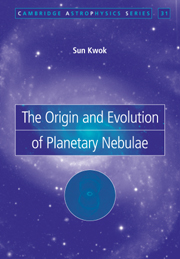Book contents
- Frontmatter
- Contents
- Preface
- 1 History and overview
- 2 Ionization structure of planetary nebulae
- 3 Nebular line radiation
- 4 Nebular continuum radiation
- 5 The neutral gas component
- 6 The dust component
- 7 Observations of the central star of planetary nebulae
- 8 Morphologies of planetary nebulae
- 9 Problems and questions
- 10 Asymptotic giant branch stars – progenitors of planetary nebulae
- 11 Evolution of the central stars
- 12 Formation of planetary nebulae
- 13 Dynamical evolution of planetary nebulae
- 14 Protoplanetary nebulae – the transition objects
- 15 Evolution to the white dwarf stage
- 16 Distances to planetary nebulae
- 17 Comparison between evolutionary models and observations
- 18 PN in the galactic context
- 19 Chemical abundances
- 20 Planetary nebulae in other galaxies
- 21 Concluding remarks
- References
- Appendix List of symbols and abbreviations
- Subject index
3 - Nebular line radiation
Published online by Cambridge University Press: 04 November 2009
- Frontmatter
- Contents
- Preface
- 1 History and overview
- 2 Ionization structure of planetary nebulae
- 3 Nebular line radiation
- 4 Nebular continuum radiation
- 5 The neutral gas component
- 6 The dust component
- 7 Observations of the central star of planetary nebulae
- 8 Morphologies of planetary nebulae
- 9 Problems and questions
- 10 Asymptotic giant branch stars – progenitors of planetary nebulae
- 11 Evolution of the central stars
- 12 Formation of planetary nebulae
- 13 Dynamical evolution of planetary nebulae
- 14 Protoplanetary nebulae – the transition objects
- 15 Evolution to the white dwarf stage
- 16 Distances to planetary nebulae
- 17 Comparison between evolutionary models and observations
- 18 PN in the galactic context
- 19 Chemical abundances
- 20 Planetary nebulae in other galaxies
- 21 Concluding remarks
- References
- Appendix List of symbols and abbreviations
- Subject index
Summary
Unlike stars which show a continuous spectrum, the optical spectrum of PN is dominated by emission lines. Line emission occurs when atoms or ions make a transition from one bound electronic state to another bound state at a lower energy. Such transitions, usually by means of spontaneous emission, are referred to as bound-bound (b-b) transitions. In the interior of stars, electrons in an atom are distributed over many energy levels because of the high particle and radiation densities. The bound electrons are excited either by free electrons colliding with the atom, or by the absorption of a photon. However, in the interstellar medium, both the particle and radiation densities are low, and the population distribution of the bound electrons can be far from the thermodynamical equilibrium condition given by the Boltzmann equation [Eq. (2.23)].
The typical energy separations between the electronic states of atoms are of the order of 1 eV, corresponding to photons in the visible or UV parts of the spectrum. The only available visible or UV background in the interstellar medium is from diluted starlight, which is generally not strong enough for excitation by stimulated absorption to be significant. Therefore the only way that a bound electron can be found in an excited state is by collisional excitation from a lower state, or as a consequence of recombination between a free electron and a proton.
- Type
- Chapter
- Information
- The Origin and Evolution of Planetary Nebulae , pp. 20 - 39Publisher: Cambridge University PressPrint publication year: 2000

